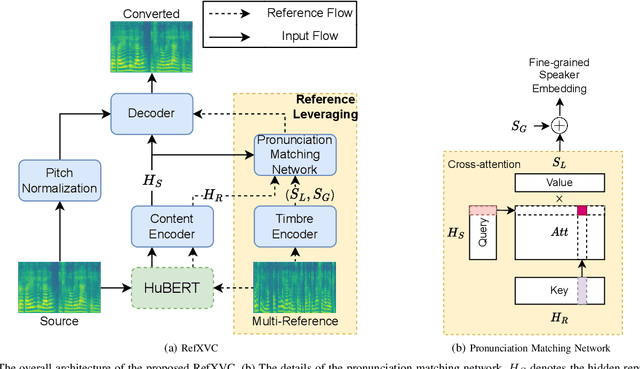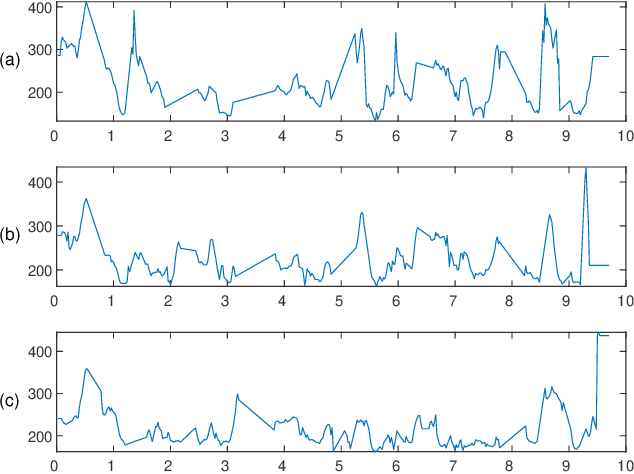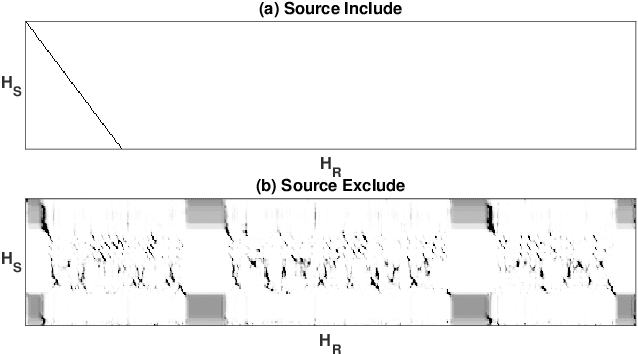Xiang Yin
Sparse Alignment Enhanced Latent Diffusion Transformer for Zero-Shot Speech Synthesis
Feb 26, 2025Abstract:While recent zero-shot text-to-speech (TTS) models have significantly improved speech quality and expressiveness, mainstream systems still suffer from issues related to speech-text alignment modeling: 1) models without explicit speech-text alignment modeling exhibit less robustness, especially for hard sentences in practical applications; 2) predefined alignment-based models suffer from naturalness constraints of forced alignments. This paper introduces \textit{S-DiT}, a TTS system featuring an innovative sparse alignment algorithm that guides the latent diffusion transformer (DiT). Specifically, we provide sparse alignment boundaries to S-DiT to reduce the difficulty of alignment learning without limiting the search space, thereby achieving high naturalness. Moreover, we employ a multi-condition classifier-free guidance strategy for accent intensity adjustment and adopt the piecewise rectified flow technique to accelerate the generation process. Experiments demonstrate that S-DiT achieves state-of-the-art zero-shot TTS speech quality and supports highly flexible control over accent intensity. Notably, our system can generate high-quality one-minute speech with only 8 sampling steps. Audio samples are available at https://sditdemo.github.io/sditdemo/.
HumanDiT: Pose-Guided Diffusion Transformer for Long-form Human Motion Video Generation
Feb 10, 2025



Abstract:Human motion video generation has advanced significantly, while existing methods still struggle with accurately rendering detailed body parts like hands and faces, especially in long sequences and intricate motions. Current approaches also rely on fixed resolution and struggle to maintain visual consistency. To address these limitations, we propose HumanDiT, a pose-guided Diffusion Transformer (DiT)-based framework trained on a large and wild dataset containing 14,000 hours of high-quality video to produce high-fidelity videos with fine-grained body rendering. Specifically, (i) HumanDiT, built on DiT, supports numerous video resolutions and variable sequence lengths, facilitating learning for long-sequence video generation; (ii) we introduce a prefix-latent reference strategy to maintain personalized characteristics across extended sequences. Furthermore, during inference, HumanDiT leverages Keypoint-DiT to generate subsequent pose sequences, facilitating video continuation from static images or existing videos. It also utilizes a Pose Adapter to enable pose transfer with given sequences. Extensive experiments demonstrate its superior performance in generating long-form, pose-accurate videos across diverse scenarios.
MimicTalk: Mimicking a personalized and expressive 3D talking face in minutes
Oct 09, 2024



Abstract:Talking face generation (TFG) aims to animate a target identity's face to create realistic talking videos. Personalized TFG is a variant that emphasizes the perceptual identity similarity of the synthesized result (from the perspective of appearance and talking style). While previous works typically solve this problem by learning an individual neural radiance field (NeRF) for each identity to implicitly store its static and dynamic information, we find it inefficient and non-generalized due to the per-identity-per-training framework and the limited training data. To this end, we propose MimicTalk, the first attempt that exploits the rich knowledge from a NeRF-based person-agnostic generic model for improving the efficiency and robustness of personalized TFG. To be specific, (1) we first come up with a person-agnostic 3D TFG model as the base model and propose to adapt it into a specific identity; (2) we propose a static-dynamic-hybrid adaptation pipeline to help the model learn the personalized static appearance and facial dynamic features; (3) To generate the facial motion of the personalized talking style, we propose an in-context stylized audio-to-motion model that mimics the implicit talking style provided in the reference video without information loss by an explicit style representation. The adaptation process to an unseen identity can be performed in 15 minutes, which is 47 times faster than previous person-dependent methods. Experiments show that our MimicTalk surpasses previous baselines regarding video quality, efficiency, and expressiveness. Source code and video samples are available at https://mimictalk.github.io .
Applying Attribution Explanations in Truth-Discovery Quantitative Bipolar Argumentation Frameworks
Sep 09, 2024



Abstract:Explaining the strength of arguments under gradual semantics is receiving increasing attention. For example, various studies in the literature offer explanations by computing the attribution scores of arguments or edges in Quantitative Bipolar Argumentation Frameworks (QBAFs). These explanations, known as Argument Attribution Explanations (AAEs) and Relation Attribution Explanations (RAEs), commonly employ removal-based and Shapley-based techniques for computing the attribution scores. While AAEs and RAEs have proven useful in several applications with acyclic QBAFs, they remain largely unexplored for cyclic QBAFs. Furthermore, existing applications tend to focus solely on either AAEs or RAEs, but do not compare them directly. In this paper, we apply both AAEs and RAEs, to Truth Discovery QBAFs (TD-QBAFs), which assess the trustworthiness of sources (e.g., websites) and their claims (e.g., the severity of a virus), and feature complex cycles. We find that both AAEs and RAEs can provide interesting explanations and can give non-trivial and surprising insights.
MulliVC: Multi-lingual Voice Conversion With Cycle Consistency
Aug 08, 2024Abstract:Voice conversion aims to modify the source speaker's voice to resemble the target speaker while preserving the original speech content. Despite notable advancements in voice conversion these days, multi-lingual voice conversion (including both monolingual and cross-lingual scenarios) has yet to be extensively studied. It faces two main challenges: 1) the considerable variability in prosody and articulation habits across languages; and 2) the rarity of paired multi-lingual datasets from the same speaker. In this paper, we propose MulliVC, a novel voice conversion system that only converts timbre and keeps original content and source language prosody without multi-lingual paired data. Specifically, each training step of MulliVC contains three substeps: In step one the model is trained with monolingual speech data; then, steps two and three take inspiration from back translation, construct a cyclical process to disentangle the timbre and other information (content, prosody, and other language-related information) in the absence of multi-lingual data from the same speaker. Both objective and subjective results indicate that MulliVC significantly surpasses other methods in both monolingual and cross-lingual contexts, demonstrating the system's efficacy and the viability of the three-step approach with cycle consistency. Audio samples can be found on our demo page (mullivc.github.io).
Generative Expressive Conversational Speech Synthesis
Aug 01, 2024



Abstract:Conversational Speech Synthesis (CSS) aims to express a target utterance with the proper speaking style in a user-agent conversation setting. Existing CSS methods employ effective multi-modal context modeling techniques to achieve empathy understanding and expression. However, they often need to design complex network architectures and meticulously optimize the modules within them. In addition, due to the limitations of small-scale datasets containing scripted recording styles, they often fail to simulate real natural conversational styles. To address the above issues, we propose a novel generative expressive CSS system, termed GPT-Talker.We transform the multimodal information of the multi-turn dialogue history into discrete token sequences and seamlessly integrate them to form a comprehensive user-agent dialogue context. Leveraging the power of GPT, we predict the token sequence, that includes both semantic and style knowledge, of response for the agent. After that, the expressive conversational speech is synthesized by the conversation-enriched VITS to deliver feedback to the user.Furthermore, we propose a large-scale Natural CSS Dataset called NCSSD, that includes both naturally recorded conversational speech in improvised styles and dialogues extracted from TV shows. It encompasses both Chinese and English languages, with a total duration of 236 hours.We conducted comprehensive experiments on the reliability of the NCSSD and the effectiveness of our GPT-Talker. Both subjective and objective evaluations demonstrate that our model outperforms other state-of-the-art CSS systems significantly in terms of naturalness and expressiveness. The Code, Dataset, and Pre-trained Model are available at: https://github.com/AI-S2-Lab/GPT-Talker.
CE-QArg: Counterfactual Explanations for Quantitative Bipolar Argumentation Frameworks (Technical Report)
Jul 11, 2024



Abstract:There is a growing interest in understanding arguments' strength in Quantitative Bipolar Argumentation Frameworks (QBAFs). Most existing studies focus on attribution-based methods that explain an argument's strength by assigning importance scores to other arguments but fail to explain how to change the current strength to a desired one. To solve this issue, we introduce counterfactual explanations for QBAFs. We discuss problem variants and propose an iterative algorithm named Counterfactual Explanations for Quantitative bipolar Argumentation frameworks (CE-QArg). CE-QArg can identify valid and cost-effective counterfactual explanations based on two core modules, polarity and priority, which help determine the updating direction and magnitude for each argument, respectively. We discuss some formal properties of our counterfactual explanations and empirically evaluate CE-QArg on randomly generated QBAFs.
RefXVC: Cross-Lingual Voice Conversion with Enhanced Reference Leveraging
Jun 24, 2024



Abstract:This paper proposes RefXVC, a method for cross-lingual voice conversion (XVC) that leverages reference information to improve conversion performance. Previous XVC works generally take an average speaker embedding to condition the speaker identity, which does not account for the changing timbre of speech that occurs with different pronunciations. To address this, our method uses both global and local speaker embeddings to capture the timbre changes during speech conversion. Additionally, we observed a connection between timbre and pronunciation in different languages and utilized this by incorporating a timbre encoder and a pronunciation matching network into our model. Furthermore, we found that the variation in tones is not adequately reflected in a sentence, and therefore, we used multiple references to better capture the range of a speaker's voice. The proposed method outperformed existing systems in terms of both speech quality and speaker similarity, highlighting the effectiveness of leveraging reference information in cross-lingual voice conversion. The converted speech samples can be found on the website: \url{http://refxvc.dn3point.com}
Contestable AI needs Computational Argumentation
May 17, 2024
Abstract:AI has become pervasive in recent years, but state-of-the-art approaches predominantly neglect the need for AI systems to be contestable. Instead, contestability is advocated by AI guidelines (e.g. by the OECD) and regulation of automated decision-making (e.g. GDPR). In this position paper we explore how contestability can be achieved computationally in and for AI. We argue that contestable AI requires dynamic (human-machine and/or machine-machine) explainability and decision-making processes, whereby machines can (i) interact with humans and/or other machines to progressively explain their outputs and/or their reasoning as well as assess grounds for contestation provided by these humans and/or other machines, and (ii) revise their decision-making processes to redress any issues successfully raised during contestation. Given that much of the current AI landscape is tailored to static AIs, the need to accommodate contestability will require a radical rethinking, that, we argue, computational argumentation is ideally suited to support.
Argumentative Large Language Models for Explainable and Contestable Decision-Making
May 03, 2024Abstract:The diversity of knowledge encoded in large language models (LLMs) and their ability to apply this knowledge zero-shot in a range of settings makes them a promising candidate for use in decision-making. However, they are currently limited by their inability to reliably provide outputs which are explainable and contestable. In this paper, we attempt to reconcile these strengths and weaknesses by introducing a method for supplementing LLMs with argumentative reasoning. Concretely, we introduce argumentative LLMs, a method utilising LLMs to construct argumentation frameworks, which then serve as the basis for formal reasoning in decision-making. The interpretable nature of these argumentation frameworks and formal reasoning means that any decision made by the supplemented LLM may be naturally explained to, and contested by, humans. We demonstrate the effectiveness of argumentative LLMs experimentally in the decision-making task of claim verification. We obtain results that are competitive with, and in some cases surpass, comparable state-of-the-art techniques.
 Add to Chrome
Add to Chrome Add to Firefox
Add to Firefox Add to Edge
Add to Edge